On the aRocket list, we get the occasional individual proposing methods to put payloads into space using mega-structures instead of rockets. This is in response to the suggestion of dropping the payload down and out a hole though the center of the Earth using a drop tower, though it could be rewritten for most novel space launch concepts.
***
A modest proposal for preventing the theorist from being a burden to this list, and for making a non-rocket space-launch that is beneficial to the publick.
You don’t need a drop tower; what you need is an elastic collision at the center of the Earth. Imagine a mass of weight 1 kg at the center of the Earth and a mass of 10 kg dropped from the Earth’s surface down a tube. At the collision, the 10 kg mass is travelling 8 km/s. After a perfectly elastic collision, the devising of which is left as an exercise to the reader, The 10 kg mass is travelling at 6.5 km/s and, more importantly, the 1 kg mass is traveling at 14.5 km/s! This speed decreases to 12.1 km/s at the surface which is more than enough speed to escape the Earth (11.2 km/s escape velocity). Low drag, converting velocity into the desired direction, and aerothermal heating are left as exercises to the reader. See Figure 1.
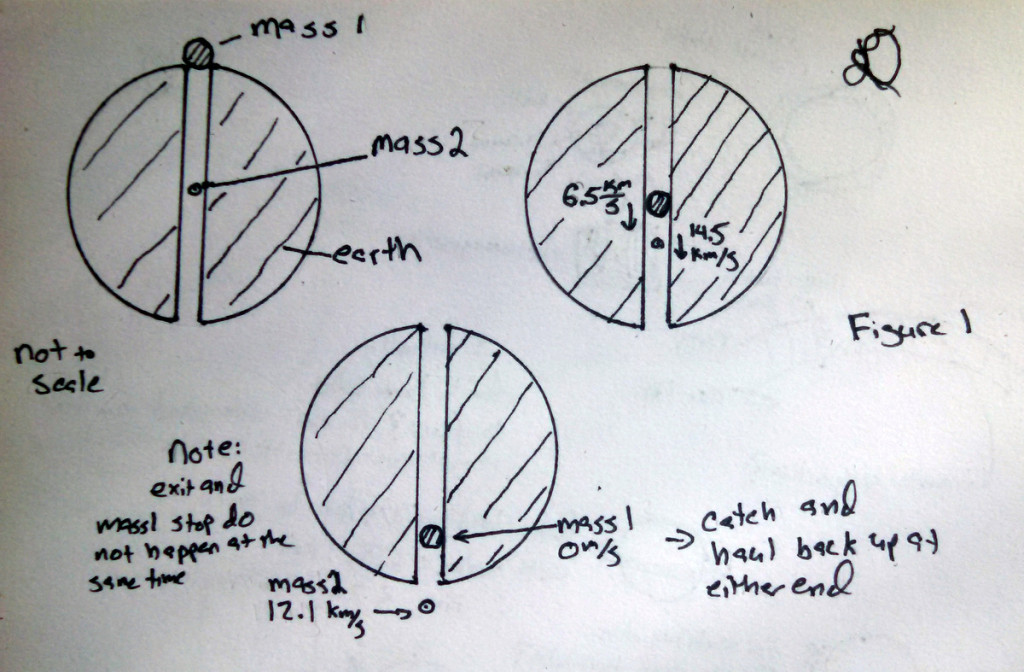
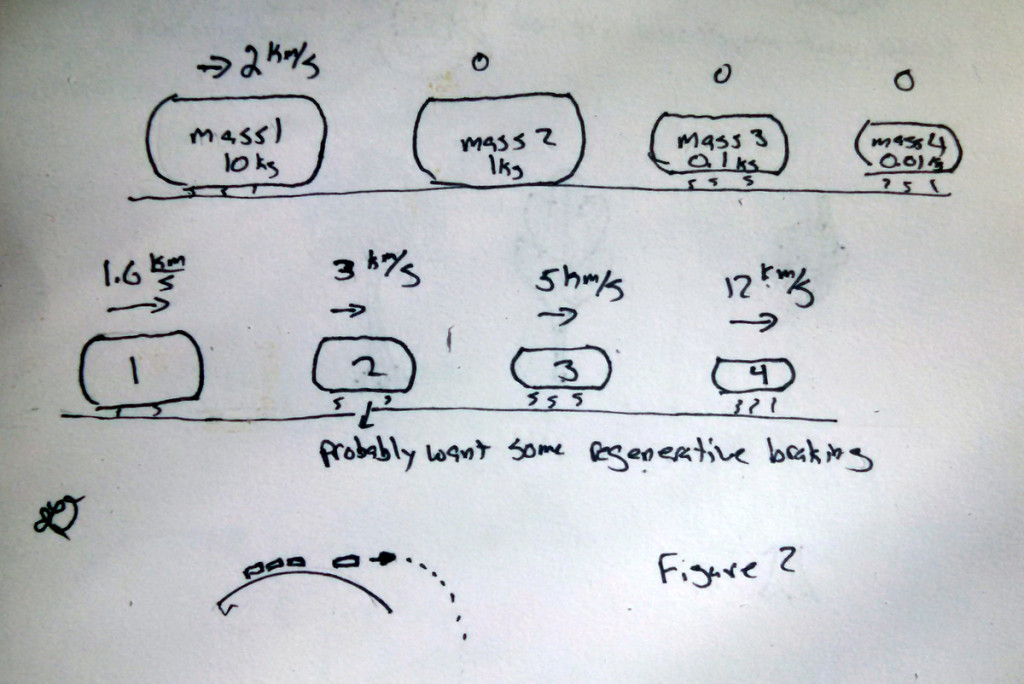
Perfectly elastic collisions are hard to achieve in large objects, but we can mimic them by throwing mass 2 off of mass 1; we just need a rail to accelerate mass 2 located on mass 1 and, instead of using stationary power, we have to beam the power to the moving mass 1. Beaming high power is left as an exercise to the reader. Now we can aim the masses and don’t have to stick to a fixed track, so we can achieve any given orbit! See Figure 3.
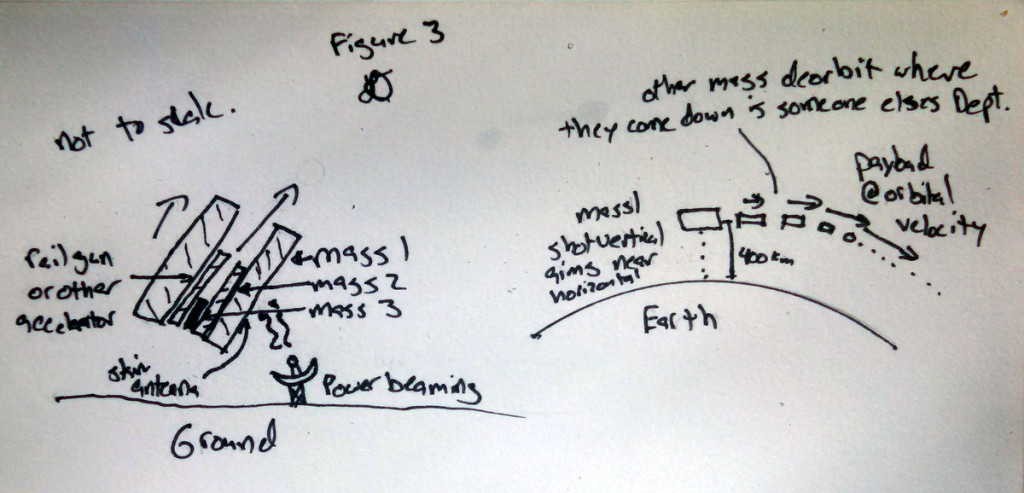
But we have to build all of these masses and mass drivers and that could be expensive. If we would stop and think for a moment, we see that we could just build one large flying mass and throw a number of smaller masses off of it. On the plus side, we lose weight as we shoot out mass which makes each additional mass add more velocity. If we stick with our 2 km/s mass driver, we have to go down to a 20-1 mass ratio (initial mass ratio) and it takes 19 pushes to achieve orbital velocity with a 20-1 mass ratio. But we only need one rail to achieve this! See figure 4.
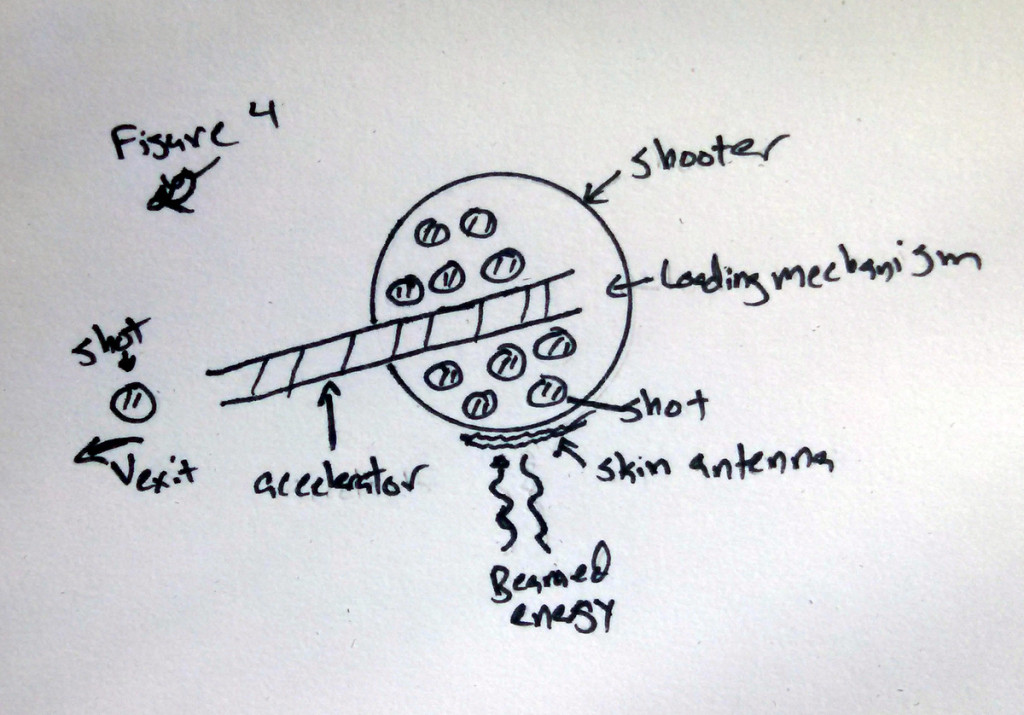
Beaming power is hard and unproven technology. But we could generate the power on board, either through nuclear or chemical reaction. This might take up a fair bit of the mass on the flying shooter mass but, it if all else fails, we can always just up the mass ratio to accommodate the generator. Also, to keep the generator from having to store energy between shots, the shot mass should be made as small as possible. Deriving the ideal shot out mass for final speed when using a very large number of small shot masses is left as an exercise to the reader. See Figure 5.
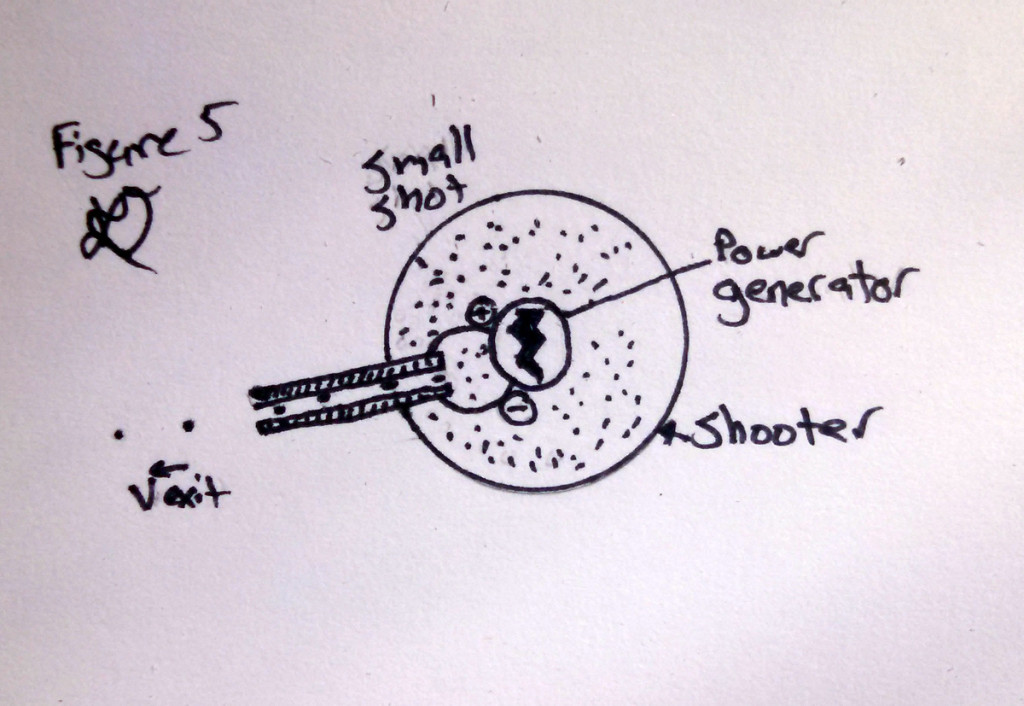
But wait! Two more finishing touches and we might make a practical system yet. It may be possible to find a way for the shot mass to generate the energy before it is thrown overboard. We can make the shot out of a variety of chemicals that generate energy when combined, for example the thermite reaction Fe2O3 + 2 Al → 2 Fe + Al2O3. + heat. Better yet, many of these reactions have gaseous by products and gasses are easy to accelerate using a simple converging diverging nozzle. For example, O2 + 3 H2 = 2 H2O+ H2 + heat which, at the reaction temperatures, are gasses the can be accelerated easily to 4 km/s which rather simplifies the shot accelerator design. Determining the optimal chemicals is left as an exercise for the reader. See Figure 6.
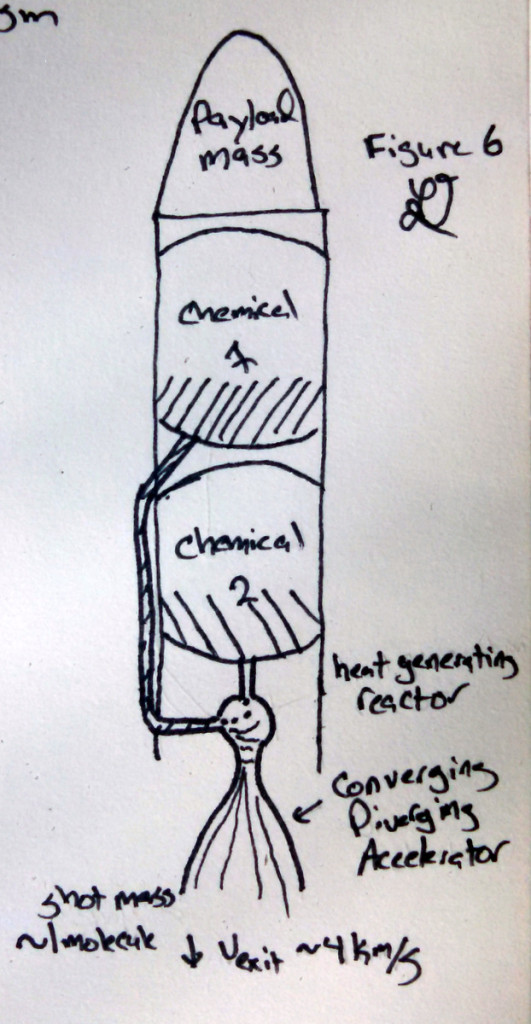
“If each of the initial elastic masses are made of convenient in-situ earthen resources, we might call each a ‘rock’ from its Terran origins.

Hey there this is kind of of off topic but I was wondering if blogs use
WYSIWYG editors or if you have to manually code with HTML.
I’m starting a blog soon but have no coding knowledge so I wanted to get guidance
from someone with experience. Any help would be
enormously appreciated!
Aw, this was a really nice post. Spending some time and
actual effort to produce a great article… but what can I say… I procrastinate
a lot and never seem to get nearly anything done.
We stumbled over here coming from a different page and thought
I should check things out. I like what I see so i am just following you.
Look forward to going over your web page for a second time.
My relatives always say that I am killing my time here at
net, except I know I am getting familiarity all the time by reading such good posts.
Hi there! This is my first comment here so I
just wanted to give a quick shout out and tell you I truly enjoy reading through your blog posts.
Can you suggest any other blogs/websites/forums that cover the same topics?
Thank you!
What’s up Dear, are you actually visiting this site regularly, if so afterward you will without doubt
take fastidious experience.
I blog quite often and I genuinely appreciate your information. The article has truly peaked my interest.
I will take a note of your blog and keep checking for
new information about once per week. I subscribed to your RSS feed
too.
Hi there, yes this paragraph is truly fastidious and I have learned lot of things from it regarding blogging.
thanks.
magnificent points altogether, you simply received a brand new reader.
What might you recommend in regards to your post that you made a few days ago?
Any certain?
mpvhHWgDkFSzK
Meds information. Generic Name.
order generic pregabalin online in USA
Some trends of drug. Get information now.
Medicine information leaflet. Generic Name.
can i buy cheap pregabalin no prescription in the USA
Best information about drug. Read now.
buy cialis online safely mycialistabs does cialis lowers blood pressure
cialis efectos secundarios cialis effects 20 mg cialis
cialis dosage 40 mg tadalafil side effects long term buy cialis online reddit
cialis interactions purchase cialis how much is cialis
things to write a persuasive essay about essay writer online how to write a song analysis essay
how to write a good essay hook being a first generation college student essay write essay your future
essay about complaint service writing an evaluation essay what to write my college essay on
essay on role of service sector in india write me an essay measuring service quality essay
non prescription viagra viagra 100mg sildenafil 100
buy real viagra online taking viagra women viagra pills
sildenafil 20mg viagra canadian pharmacy ezzz otc viagra
viagra or cialis cialis without a doctor prescription cialis free trial coupon
general resume objective edit my resume real estate agent resume
cialis 5mg website how cialis works
cover letter font cover letter for employment medical assistant cover letter
research assistant resume nursing resume letter of interest vs cover letter
front desk resume best resume review services hair stylist resume
buy generic 100mg viagra online edviagramaster.net sildenafil 20 mg
viagra pills https://sildenafilviagratop.com viagra 100mg
viagra canada prescription cheap generic viagra sildenafil citrate 100mg
canada pharmacy cialis cialis otc cialis for daily use side effects
cialis generic cost cialis for daily use cialis without a doctor prescription usa
viagra and cialis cialis pills how much is cialis
buy cialis cheap cialis instructions cialis 5mg daily how long before it works
база предприятий россии
Greetings from Ohio! I’m bored at work so
I decided to browse your website on my iphone during lunch break.
I love the information you provide here and can’t wait to take a look when I
get home. I’m surprised at how fast your blog loaded on my cell phone ..
I’m not even using WIFI, just 3G .. Anyways, excellent site!
Hi, its pleasant article about media print, we all be
aware of media is a fantastic source of facts.
nYNLPGwyMgufcqZB
foreign service exam essay preparation buy term paper review of global essay writer service
SYjtFVRxqzlaA